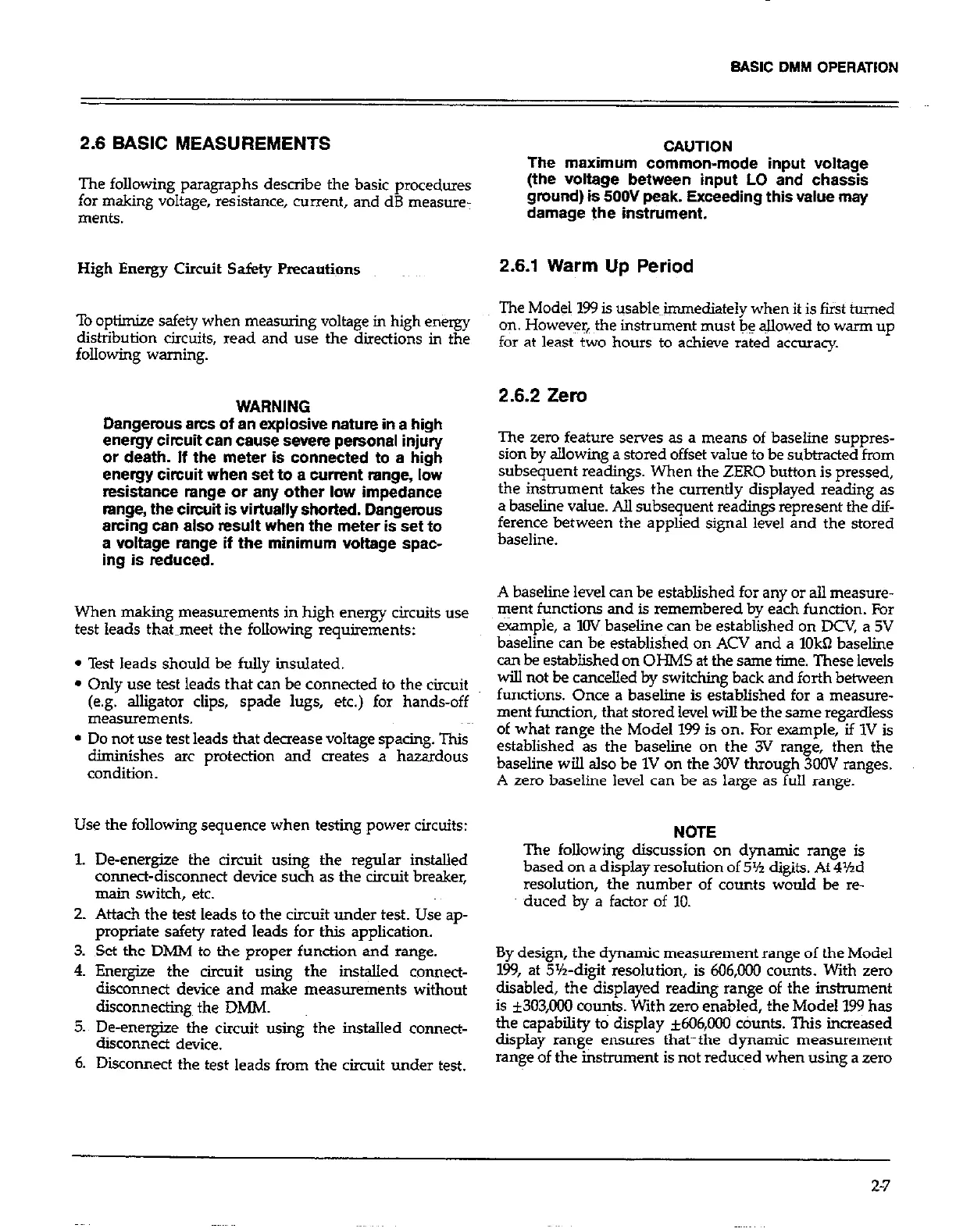BASIC DMM OPERATION
2.6 BASIC MEASUREMENTS
The following paragraphs describe the basic procedures
for making voltage, resistance, current, and dB measure-
ments.
High Energy Circuit Salty Precauticms
To optimize safety when measuring voltage in high energy
distribution circuits, read and use the directions in the
following warning.
WARNING
Dangerous arcs of an explosive nature in a high
energy circuit can cause severe personal injury
or death. If the meter is connected to a high
energy circuit when set to a current range, low
resistance range or any other low impedance
range, the circuit is virtually shorted. Dangerous
arcing can also result when the meter is set to
a voltage range if the minimum voltage spac-
ing is reduced.
When making measurements in high energy circuits use
test leads that-meet the following requirements:
l Test leads should be fully insulated.
l Only use test leads that can be connected to the circuit
(e.g. alligator clips, spade lugs, etc.) for hands-off
measurements.
l Do not use test leads that decrease voltage spacing. This
diminishes arc protection and creates a hazardous
condition.
Use the following sequence when testing power circuits:
1.
2.
3.
4.
5.
6.
De-energize the circuit using the regular installed
connect-disconnect device such as the circuit breaker,
main switch, etc.
Attach the test leads to the circuit under test. Use ap-
propriate safety rated leads for thii application.
Set the DMh4 to the proper function and range.
Energize the circuit using the installed connect-
disconnect device and make measurements without
disconnecting the DMM.
De-energize the circuit using the installed connect-
disconnect device.
Dkonnect the test leads from the circuit under test.
CAUTION CAUTION
The maximum common-mode input voltage The maximum common-mode input voltage
(the voltage between input LO and chassis (the voltage between input LO and chassis
ground) is 500V peak. Exceeding this value may ground) is 500V peak. Exceeding this value may
damage the instrument. damage the instrument.
2.6.1 Warm Up Period
The Model 199 is usablq~jmmediately when it is f&t turned
on. Howeve!, the instrument must be aowed to warm up
for at least two hours to achieve rated accuracy.
2.6.2 Zero
The zero feature serves as a means of baseline %uppres-
sion by allowing a stored offset value to be subtracted from
subsequent readings. When the ZERO button is pressed,
the instrument takes the currently displayed reading as
a baseline value. All subsequent readings represent the dif-
ference between the applied signal level and the stored
baseline.
A baseline level can be established for any or all measure-
ment functions and is remembered by each function. For
Ample, a 1OV baseline can be established on DCV, a 5V
baseline can be established on ACV and a 1OkQ baseline
can be established on OHMS at the same time. These levels
will not be cancelled by switching back and forth between
functions. Once a baseline is established for a measure-
ment function, that stored level wiU be the same regardless
of what range the Model 199 is on. For example, if 1V is
established as the baseline on the 3V range, then the
baseline will also be 1V on the 30V through 3oOV ranges.
A zero baseline level can be as large as full range.
NOTE
The following discussion on dynamic range is
based on a disolav resolution of 5% dieits. At 41/zd
”
resolution, th’e Lumber of counts would be re-
duced by a factor of 10.
By design, the dynamic measurement range of the Model
199, at 5%digit resolution, is 606,OKl counts. With zero
disabled, the displayed reading range of the instrument
is GO3,OCHl counts. With zero enabled, the Model 199 has
the capability to display ~606,OCKl c&n-&. This increased
display range ensures that~~the dynamic measurement
range of the instrument is not reduced when using a zero
2-7
